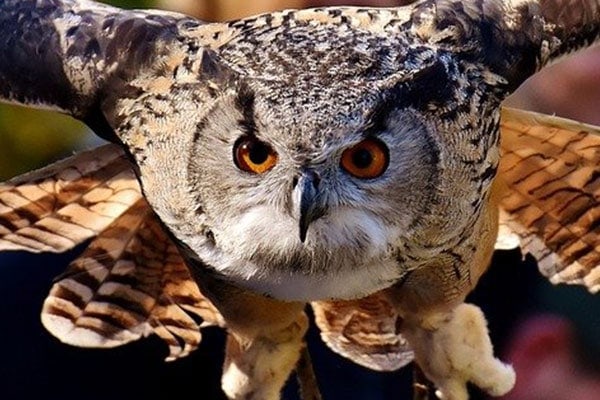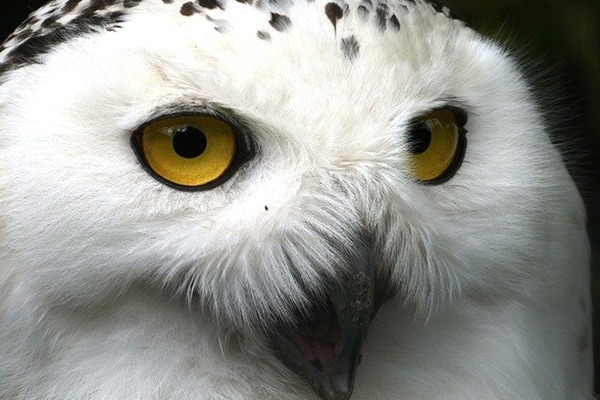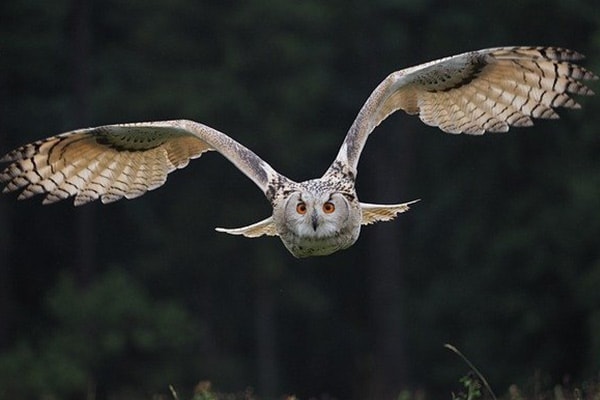Contents
When you look at an owl, you can’t help but look at their big eyes. Have you ever wondered why do owls have big eyes? So have I…
Owls have large eyes to enable them to see in low-light conditions since the majority of owls are nocturnal. Their big eyes help them hunt very effectively. The large facial rings surrounding an owl’s eyes help to reflect light towards their eye, further improving the efficiency of their low-light vision capabilities. An owl’s eye sight is approximately 10 to 100 times better than humans.
That is only a small part of why they need their big eyes. Join me as we unravel this mystery and learn more about these nocturnal creatures. Learn more about:
- How owls process what they see
- Why can’t they move their eyes?
- Can they see in the dark?
- Colorblind owls
Bird’s Eye View: How Do Owls See

One of the most remarkable traits of owls is their eyes. You can get lost in those beautiful colored eyes if you stare at them for too long.
Owls’ eyes work mostly the same as how the human eyes work. However, the main difference is that they don’t have eyeballs that can move. instead, their tube-shaped eyes are set in place by bones that are called the sclerotic rings. This anatomy, and their field of vision, is why owls must twist their entire head just to look at something.
Below is a field of vision comparison for several different animals, sorted by total field of vision:
| Species | Binocular Field of Vision | Total Field of Vision |
|---|---|---|
| Cooper’s Hawk | 36° | 300° |
| Puffin | 49° | 298° |
| Eagles | 33° | 278° |
| Dogs | 60° | 240° |
| Cats | 140° | 210° |
| Humans | 140° | 180° |
| Owls | 70° | 110° |
So, while owls have a relatively poor TOTAL field of vision, their eye sight is particularly well adapted to low light conditions, allowing them to hunt at night. Their eyes are very efficient in collecting and processing light.
And, owls overcome their poor total field of vision by being able to rotate their heads up to 270°.
Here are the components of an owl’s eye:
- Cornea – this is the transparent coating of an owl’s eyes
- Pupil – this is the opening at the center of the eye. The pupil’s size is controlled by the iris
- Iris – this is the colored membrane suspended between the cornea and the lens
- Lens – this is where light passes through when the pupil gets larger
- Retina – this is a light-sensitive tissue on which the image is then formed
The retina allows them to collect more light for them to see better, even in dimmer situations. That is why they make the best night hunters the animal kingdom has ever seen.
Do Owls See Color?

The retina is where it is all formed. It has an abundance of light-sensitive cells called rod cells. These rod-shaped cells are the reasons that an owl’s sight is this evolved. Though these cells are sensitive to movent and light, they do not respond well to color. All animals have receptors in the eyes that are either cone-shaped or rod-shaped.
Cone-shaped receptors react way better than the rods. They see more color because of the cone cells.
Since owls have rod cells in their eyes with a few cone cells, they can only see in very limited color. There are also some owls that only see monochrome colors.
This, however, is an advantage to our owl friends because rods function at their best in dim lighting situations. Even the great horned owl have these for them to be able to hunt better at night. When it comes to species, they say that there is a 30:1 ratio that has rod-shaped eyes versus cone-shaped ones.
Night Vision Eyes

Consequently, the rod-shaped eyes of owls actually help them to see better at night. Aside from their inability to see color, these eyes have a greater number of photoreceptors compared to the human eye.
Their big eyes can gather more light so that they could see better at night. As the retina absorbs the light in the dark, the pupil gets larger allowing them to see more than the human eye.
A misconception that since the owls have night vision, that they don’t see during the day. That is completely wrong. They still can see, however, due to the abundance of light that passes through their eyes, their vision during the day is greatly affected.
Unlike our own eyes, their pupils do not shrink in broad daylight. What they do is that they close their eyes halfway to get a better view of what is going on.
So, yes, they can still see perfectly during the day. They might not just have those big beautiful bird eyes open the whole way through.
By the way, have you ever wondered where do owls go during the day? Click the link to check it out.
Do Owls Have Three Eyelids?
Yes…
Like many other animals, owls have 3 eyelids that protect their very big eyes. These eyelids all serve the owls a different purpose.
The upper lid closes every time the owl blinks. The lower lid closes when the owl is sleeping. Lastly, owls have a 3rd eyelid called the Nictitating membrane.
The Nictitating Membrane
The nictitating membrane is a soft eyelid that closes diagonally across the owl’s eyes. All birds including owls have this eyelid. This is most known for cleansing and protecting the bird’s eyes.
This is especially useful for owls when they go hunting. This protects their eyes from any injury while attacking their prey, all the while allowing them to see.
A lot of scientists had thought that these membranes protect the owl’s eyes from sunlight and artificial light. You may have seen some owl’s in the street directly looking at the street light. Some believed that these nictitating membranes act as shades for the owls.
A recent study has debunked that theory by testing it on barn owls. They directly shone artificial light in the ow’s face at a distance of 12 inches for 15 seconds. In this study, the owls did not use their nictitating membrane to protect themselves from the harsh lights.
This proves that this membrane is good for protecting their eyes not from light but from injuries when owls hunt their prey (check out our article titled, “How Do Owls Hunt?“).
Wrapping Up: Why Do Owls Have Big Eyes…
Owls have big eyes to help them see better at night, enabling them to be very effective hunters.
Their eyes process and absorb more light than us. However, the downside is that they cannot see in full color. Some owls can only see partial colors and others only have monochrome vision.
To protect their big eyes from being damaged, a 3rd membrane-like eyelid closes. It is see-through so when they hunt, they can keep their eyes protected while attacking their prey.
The next time you see the eyes of an owl, don’t be fooled to think that those are innocent eyes, their eyes are meant to kill.
Related articles:
